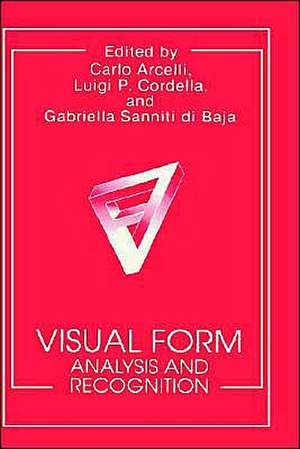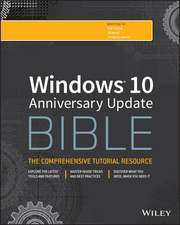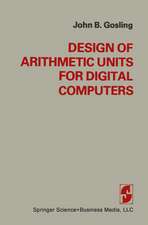Visual Form: Analysis and Recognition
Editat de C. Arcelli, L.P. Cordella, G.S. di Bajaen Limba Engleză Hardback – 31 mai 1992
| Toate formatele și edițiile | Preț | Express |
|---|---|---|
| Paperback (1) | 1289.59 lei 6-8 săpt. | |
| Springer Us – 22 iun 2013 | 1289.59 lei 6-8 săpt. | |
| Hardback (1) | 1296.69 lei 6-8 săpt. | |
| Springer Us – 31 mai 1992 | 1296.69 lei 6-8 săpt. |
Preț: 1296.69 lei
Preț vechi: 1620.86 lei
-20% Nou
Puncte Express: 1945
Preț estimativ în valută:
248.12€ • 259.99$ • 205.12£
248.12€ • 259.99$ • 205.12£
Carte tipărită la comandă
Livrare economică 11-25 aprilie
Preluare comenzi: 021 569.72.76
Specificații
ISBN-13: 9780306441851
ISBN-10: 0306441853
Pagini: 644
Ilustrații: XII, 644 p.
Dimensiuni: 178 x 254 x 40 mm
Greutate: 1.11 kg
Ediția:1992
Editura: Springer Us
Colecția Springer
Locul publicării:New York, NY, United States
ISBN-10: 0306441853
Pagini: 644
Ilustrații: XII, 644 p.
Dimensiuni: 178 x 254 x 40 mm
Greutate: 1.11 kg
Ediția:1992
Editura: Springer Us
Colecția Springer
Locul publicării:New York, NY, United States
Public țintă
ResearchCuprins
Thinning of Gray-Scale Images with Combined Sequential and Parallel Conditions for Pixel Removal.- Shape Decomposition Using Structured Light Vision.- Reversible Skeletonization by (5,7,11)-Erosion.- Perception of 3-D Objects by a Robotic Stereo Eye-in-Hand Vision System.- Motion and Structure in Rigid Multi-Surfaced Stationary Environments Using Time-Varying Image Velocity: Linear Solutions.- Parallel Simulated Annealing for Shape Detection.- Filling and Analysing Concavities of Digital Patterns Parallelwise.- Shape from Occluding Contours: a Regularization Method.- Towards Representation of 3D Shape: Global Surface Parametrization.- Differential Invariants of Planar Curves and Recognizing Partially Occluded Shapes.- Three-Dimensional Surface Reconstruction Using Delaunay Triangulation in the Image Plane.- Multidimensional Indexing for Recognizing Visual Shapes.- Circular Shape Detection in Remote Sensing Multispectral Images.- Orthogonal Zig-Zag: an Efficient Method for Extracting Straight Lines from Engineering Drawings.- Massively Parallel Processing of Image Contours.- Classifying Character Shapes.- Detecting Digital Straight Line Segments in O(N2).- Computing Egomotion and Shape from Image Motion Using Collinear Points.- Extraction and Representation of Shape Features for CAD/CAM Applications.- 3-D Object Recognition from Single Perspective Views.- Search and Replace of 2-D Objects in Digital Images.- Primitive-Based Shape Modeling and Recognition.- Qualitative Shape — Some Computational Aspects.- Fast Thinning Algorithms for Large Binary Images.- 3D Object Recognition by Integration of Associative and Symbolic Techniques.- A New Approach to Affine Transform Invariant Shape Matching.- Model-Based Morphology: Simple and Complex Shapes.- Human Face MotionAnalysis.- A Computational Model of Mathematical Morphology.- Determining the Symmetry of Polyhedra.- Depth Data Segmentation Using Robust Estimation in a Hierarchical Data Structure.- Shape Recognition Under Affine Distortions.- Entropy Scale-Space.- A New Contour Generation Thinning Algorithm.- The Visual Hull and Its Computation in 2-D.- Shape Description Using Geons as 3D Primitives.- Shape and Causal-History.- Shape Representation and Recovery Using Deformable Superquadrics.- From Voxels to Curvature Features.- The Dimensions of Shape and Form.- Shape Classification by Using Associative Memories.- Applications of Splines to Shape Description.- 3D Medial Surfaces and 3D Skeletons.- A Review of Hierarchical Representations of Shape and Some Applications.- Estimating Curvature by Kalman Filters.- View-Class Representation and Matching of 3D Objects.- Occlusions and Perspective in an Image Sequence.- Detecting Round Regions.- On Symmetric Forms of Discrete Sets of Points and Digital Curves.- Extraction of Surface Orientation Using Gray Level Difference Statistics.- Shape Splitting from Medial Lines Using the 3–4 Chamfer Distance.- Distance Transformation and Skeleton for Shape Feature Analysis.- Forms Structure Form at Ever “Higher” and “Lower” Levels.- Human Perception of Affine Equivalent Polygons.- 3-D Pose Estimation by an Improved Kohonen-Net.- On the Recognition of Articulated Objects (Generalizing the Generalized Hough Transform).- Analysis of Straight Homogeneous Generalized Cylinders Under Perspective Projection.- Invariants and Pose Determination.- Characteristic Pattern Based on Mathematical Morphology.- Contributors.












